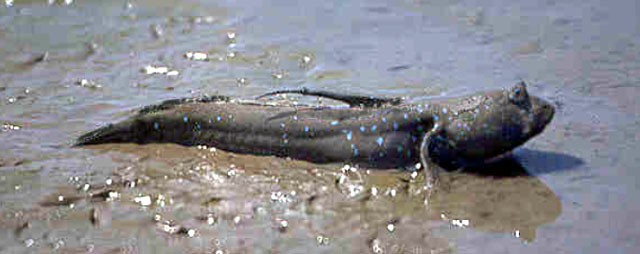| Oxudercidae (Mudskippers), subfamily: Periophthalminae |
| 17.5 cm TL (male/unsexed); 22 cm (female); max.weight: 91.4 g; max. reported age: 4 years |
|
demersal; freshwater; brackish; marine; pH range: 8 - 8.5; depth range - 0 m, non-migratory |
| Northwest Pacific: China, Korean Peninsula, Japan and Taiwan. |
|
Dorsal soft rays (total): 24-31; Anal soft rays: 24-30. Distinguished by the following characteristics: Total elements in D2 23-26; caudal fin length 18.3-22.2% SL; head length 24.3-28.0% SL; length of D2 base 41.5-46.1% SL; first D2 element usually segmented and branched; longitudinal scale count 84-123; predorsal scales 26-48; lower jaw teeth notched (Ref. 5218). |
| An intertidal and amphibious air-breather that actively shuttles back and forth between tide pools and air (Ref. 31184). Creeps around and browses on mud flats at low tide; stays in a burrow in the mud at high tide. Herbivores that graze on diatoms on the mud surface during low tide (Ref. 92840). Caught for food. Used in Chinese medicine (Ref. 12166). |
|
Not Evaluated (N.E.) Ref. (130435)
|
| harmless |
Source and more info: www.fishbase.org. For personal, classroom, and other internal use only. Not for publication.
